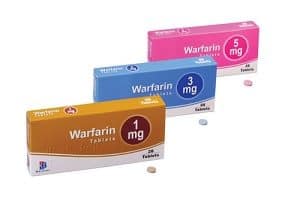
Warfarin Blood Clot Risks. Our firm is investigating potential lawsuits on behalf of patients who have taken the blood thinner warfarin, which is sold under the brand names Coumadin and Jantoven. Warfarin is an oral vitamin K antagonist that was discovered in the 1940s and introduced by Endo Laboratories in 1954 for use in humans. […]
 Warfarin Blood Clot Risks. Our firm is investigating potential lawsuits on behalf of patients who have taken the blood thinner warfarin, which is sold under the brand names Coumadin and Jantoven. Warfarin is an oral vitamin K antagonist that was discovered in the 1940s and introduced by Endo Laboratories in 1954 for use in humans.
Warfarin Blood Clot Risks. Our firm is investigating potential lawsuits on behalf of patients who have taken the blood thinner warfarin, which is sold under the brand names Coumadin and Jantoven. Warfarin is an oral vitamin K antagonist that was discovered in the 1940s and introduced by Endo Laboratories in 1954 for use in humans.
Warfarin is typically prescribed to older adults for prevention of strokes, blood clots, and heart attacks. Warfarin dosing must be closely monitored as too much may lead to internal bleeding and an insufficient dose may allow for the formation of deadly blood clots.
Blood thinners, such as warfarin, disrupt the body’s ability to clot blood. Typically, the body forms clots to avoid deadly, uncontrolled bleeding, a process that involves various clotting factors. Blood thinners are prescribed to stop clots from blocking the flow of blood that may lead to heart and brain damage in people at risk for heart attack and stroke, including those diagnosed with atrial fibrillation; a birth defect of the heart; deep vein thrombosis (DVT) and a pulmonary embolism involving a DVT that stops blood flow to the lungs; previous heart valve surgery; and pulmonary hypertension (high blood pressure affecting the heart and lungs).

Vitamin K is used by multiple factors to assist in blood clotting. Warfarin blocks the blood clotting factors that rely on vitamin K from forming, but is not prescribed to completely stop blood from clotting as this may result in death.
Patients taking warfarin must undergo routine, ongoing monitoring, typically once every two to four weeks, depending on blood test results, which are conducted to determine how long it takes a patient’s blood to clot using what is known as a prothrombin time test. This test measures the International Normalized Ratio (INR). A high INR reveals an increased risk of uncontrollable bleeding; a low INR indicates increased risks for blood clots. The warfarin dose is adjusted based on INR results.
Warfarin Side Effects and Interactions
Should the wrong warfarin dose be taken, risks for uncontrollable bleeding or increased risks of stroke or heart attack occur. Although there are antidotes to reverse warfarin bleeding, with no antidote, a warfarin bleed may rapidly become deadly. Warfarin clots or bleeds may lead to serious side effects, or side effects may be worsened:
Warfarin also interacts with various substances and activities; therefore, patients taking warfarin should speak with their healthcare providers regarding prescription and over-the-counter medications, supplements, activities, and diet:
Some medications might decrease warfarin’s anticoagulant effect, including Tegretol (carbamazepine); Luminal (phenobarbital); Dilantin (phenytoin); Rifadin (rifampin); vitamin K (multiple brands); Questran, Questan Light (cholestyramine); and Carafate (sucralfate). While some medications might increase warfarin’s anticoagulant effect, including Cordarone®, Pacerone (amiodarone); Bactrim, Septra (co-trimoxazole); Cipro (ciprofloxacin); Biaxin (clarithromycin); erythromycin (various brands); Diflucan (fluconazole); Sporanox (itraconazole); Nizoral (ketoconazole); Mevacor (lovastatin); and Flagyl (metronidazole).
A study published in 2015 by Quest Diagnostics discovered that patients taking Coumadin, or its generic, had laboratory results that revealed that Coumadin and warfarin only had the sought-for effect 54 percent of the time.
A 2011 report published in the New England Journal of Medicine discovered that warfarin was associated with 33,000 emergency hospitalizations among the senior population from 2007 to 2009, which is more than two-fold the amount of the next highest drug, insulin.
The incidence of warfarin-associated bleeding events and concomitant use of potentially interacting medicines was studied in 2011 based on reports to the Norwegian spontaneous reporting system, according to the British Journal of Clinical Pharmacology. Researchers reviewed data on warfarin bleeding and focused on time to bleed, use of concomitant (associated) drugs, and report evaluation. Researchers concluded that the concomitant use of potentially interacting drugs were involved in most of the reported warfarin-associated bleeding events; however, warfarin was, generally, the only contributing factor to bleeding and interacting medications were not suspected.
Another study published in 2011 in the Western Journal of Emergency Medicine revealed that warfarin therapy may be problematic due to what was described as its “narrow therapeutic index, highly variable dosage requirements among patients, and significant drug, dietary, and disease reactions.” Researchers also found that sometimes undiagnosed, “subtle” changes may also increase hemorrhagic complications tied to warfarin therapy. Researchers concluded that there is no optimal therapy or anticoagulant overdose
A 2007 peer-reviewed study published in The American Journal of Medicine revealed that nursing home residents suffer 34,000 fatal, life-threatening, or serious events related to warfarin annually, according to ProPublica and the Washington Post. North Carolina data revealed that more medication errors occur in nursing homes involving Coumadin than any other drug.
DuPont settled a class-action lawsuit for $44.5 million in 2002 for illegally maintaining exclusive rights for warfarin after its patent expired. Allegations included that DuPont forced consumers to spend millions of dollars more than they would have spent on generic versions.
Warfarin is a significant issue for elderly patients in nursing homes. Between 2011 and 2014, more than 165 nursing home patients required hospitalization or died due to monitoring errors involving warfarin. Studies suggest that thousands of additional injuries occur that are never investigated.
According to ProPublica and the Washington Post, some nursing home facilities do not appropriately oversee warfarin use. In one case, an 85-year-old man was brought into the emergency room in October 2013 covered in bruises and with blood oozing from his gums. One bruise reportedly spanned from the middle of his stomach to his hip. The man took Coumadin at his nursing home; however, testing was not conducted, despite the bruises that spread over two-weeks, according to government inspectors. The man died just a few days late, ProPublica and the Washington Post reported. “It’s an insidious problem,” Rod Baird, president of Geriatric Practice Management, a firm that creates electronic health records for doctors who work in long-term care facilities, told ProPublica and the Washington Post. Baird said that, because it is easy to make mistakes with dosing, “Coumadin is the most dangerous drug in America.”
In another case, an 89-year-old woman recovering from hip surgery died from internal bleeding after a facility gave her an antibiotic that increases the Coumadin’s effects and did not advise her doctor. Another woman was hospitalized over blood clots in her legs after the nursing home where she was a resident did not treat her with Coumadin for 50 days and did not perform the blood tests ordered by her physicians. She suffered permanent damage.
Another nursing home resident received Coumadin for 34 days “without a physician order or adequate monitoring” and was sent to the hospital when blood began pooling in his mouth. In another case, a nursing home patient underwent three operations for a blood clot after not receiving 17 doses of warfarin. Another case involved a patient prescribed Coumadin who was hospitalized after clotting tests were not conducted for one month. An internal review revealed that a nurse “mistakenly put the February labs on the wrong month,” according to ProPublica and the Washington Post. In other cases, although testing was conducted, nursing homes neglected to advise doctors of abnormal patient results. In one case, a doctor was not advised when lab results revealed that a patient’s blood took too long to clot. The patient passed out and had no heartbeat when staff assisted the resident to the bathroom.
In a number of cases, patients taking Coumadin fell, and nursing homes were cited for not acting sufficiently. One nursing home resident taking Coumadin fell and hit his head during and exercise class. The nurse reported that she did not contact his physician because the doctor “didn’t like to be called at night unless it was an emergency.” The man died following massive bleeding in the brain, wrote ProPublica and the Washington Post.
Following a weeklong stay in the hospital, a man was returned to the nursing home and prescribed Coumadin, according to a government inspection report. The hospital and his physician left instructions for testing, which was never conducted. Staff members noted in the patient’s chart about bruises on his body, including a number that mentioned scattered bruising; one described a large bruise on the right abdomen. The man was taken to the emergency room due to bleeding gums. Tests revealed his blood took so long to clot that the bleeding might never stop on its own. When bleeding reversal attempts were made, the man became confused, agitated, nearly belligerent, and had difficulty breathing. By the time he was brought to his room, he was unresponsive. He died the next morning.
If you or someone you know sustained injury, including blood clots or uncontrolled bleeding associated with taking, or not being appropriately monitored for warfarin, Coumadin, or Jantoven, you may have valuable legal rights, including filing a lawsuit. We urge you to contact our injury lawyers today by filling out our online form, or calling 1-800-YOURLAWYER (1-800-968-7529).


